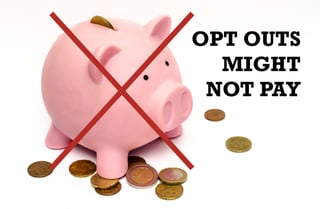 Employers often offer an opt-out benefit to their employees who elect to waive health care coverage for the year. On December 16, 2015, the IRS, the Department of Health and Human Services, and Department of Labor issued Notice 2015-87, which provides guidance on various provisions of the Affordable Care Act (ACA) to employer-provided health coverage.
Employers often offer an opt-out benefit to their employees who elect to waive health care coverage for the year. On December 16, 2015, the IRS, the Department of Health and Human Services, and Department of Labor issued Notice 2015-87, which provides guidance on various provisions of the Affordable Care Act (ACA) to employer-provided health coverage.
Part III of that notice addresses certain aspects of the employer shared responsibility provisions of Internal Revenue Code §4980H (the “play-or-pay” penalty), including the relationship between medical plan opt-out payments and the 9.5% affordability threshold under the ACA affordability safe harbors. Let’s discuss what you need to know to remain compliant.
Notice 2015-87 Defined
In this Notice, the IRS confirmed that the required contribution toward coverage for play-or-pay purposes should include any unconditional opt-out payment. The Notice defines an unconditional opt-out payment as “an arrangement providing for a payment conditioned solely on an employee declining coverage under an employer’s health plan, and not on an employee satisfying any other meaningful requirement related to the provision of health care to employees, such as a requirement to provide proof of coverage provided by a spouse’s employer.”
Examples of the Opt-Out Payment Put to Use
Example 1: If an employer offers employees group health coverage through a §125 cafeteria plan, requiring employees who elect self-only coverage to contribute $200 per month toward the cost of that coverage, and offers an additional $100 per month in taxable wages to each employee who declines the coverage, the offer of $100 in additional compensation has the economic effect of increasing the employee’s contribution for the coverage.
In this case, the employee contribution for the group health plan effectively would be $300 ($200 + $100) per month, because an employee electing coverage under the health plan must forgo $100 per month in compensation in addition to the $200 per month in salary reduction.
Example 2: For each calendar month, a full-time employee is required to pay $75 per month for the lowest cost self-only minimum value medical coverage offered by her employer. This amount is equal to or less than 9.5% (as adjusted) of the mainland single federal poverty line for that year. The employer also pays an opt-out cash benefit of $1,500 to employees who waive coverage under the employer’s plan. The receipt of the payment is conditioned solely on the employee declining the employer’s offer of coverage.
Under this new IRS guidance, the employee’s required contribution for health coverage is $200 per month. This amount consists of the $75 employee premium share plus $125 per month lost opportunity cost (the $1,500 opt-out payment divided by 12 months). Thus, the $200 value is used for affordability calculation purposes. The 1A (federal poverty limit) code for line 14 would no longer apply and the employer would have to look at the wages paid to all employees to determine if the Rate of Pay or W-2 safe harbor(s) are satisfied on whether a potential “B” excise tax penalty exists if the rate being charged is now deemed to be unaffordable.
Exceptions to the Notice
The Notice clarifies that employers that offered an opt-out arrangement on December 16, 2015, including certain employers that had provided written communications to employees about an opt-out arrangement prior to December 16, 2015, are not subject to this rule in 2015 or 2016. This means that these employers do not have to include the amount of the opt-out payment in their affordability analysis or in the cost of coverage reported on Form 1095-C until final regulations are issued, which is not expected to be prior to January 1, 2017. However, until further guidance is issued, an employee may treat the opt-out payment as increasing the employee’s required contribution for purposes of determining the employee’s eligibility to receive a premium subsidy for coverage purchased on the exchange.



